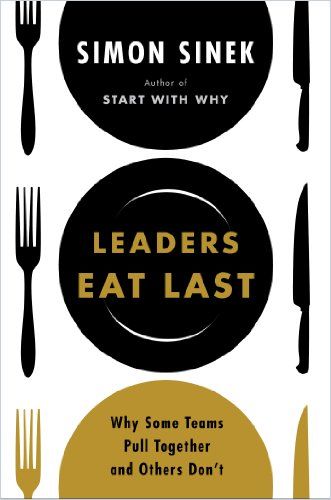TED star and best-seller Simon Sinek says companies need both hierarchy and collaborative leadership.

Leaders serve first.
Simon Sinek’s Start with Why shares the title of his TED Talk, the second most popular video on TED.com. In this Wall Street Journal and New York Times bestseller, Sinek challenges assumptions about how and why people seek and accept inspiration from leaders and organizations.
To earn the trust of people, the leaders of an organization must first treat them like people. To earn trust, he must extend trust.Simon Sinek
After interviewing representatives of the Congress, high-level United States military officers and corporate leaders, Sinek cites examples from his conversations and from history to demonstrate how thoughtful, charismatic and successful leaders inspire trust by putting other people first.
Sparta
Sparta, a small Greek city-state, mounted an equally small army that inspired both dread and admiration among its allies and enemies due to its power, bravery and fortitude. Ancient Spartans reserved their toughest punishments for their own soldiers who dropped or lost their shields, since a soldier who surrendered his shield put his compatriots at risk. Sparta stripped a soldier who lost his shield of his most precious asset: his Spartan citizenship – his proof of belonging to the community.
Exceptional organizations all have cultures in which the leaders provide cover from above and the people on the ground look out for each other…and the way any organization can achieve this is with empathy.Simon Sinek
Sinek asserts that many corporate titans haven’t learned the lesson of servant leadership. They continue to put their own interests first, costing their companies money and credibility. He pulls no punches in calling out firms that place shareholder value above protecting their people, and he finds plenty of examples.
Oxytocin and Cortisol
Human beings are hardwired to cooperate with one another to fight outside threats. When people collaborate to reach a goal, Sinek explains, their brains release a feel-good chemical – oxytocin.
On the other hand, in an environment of distrust, the brain releases cortisol, a stress chemical associated with responding to danger. In this explanation of brain chemistry, Sinek argues compellingly that maintaining a high-trust corporate culture makes good business sense because contented, stress-free employees emitting oxytocin, work longer and harder and with greater enthusiasm. In comparison, a corporate culture of distrust stifles collaboration, inspiration, curiosity and common goals.
When trust and cooperation thrive internally, we pull together and the organization grows stronger as a result.Simon Sinek
This is practically common wisdom now, but it demonstrates that Sinek was ahead of his time when he first explained these factors in 2014. In another example, long before psychological safety in the workplace was a hot topic, Sinek urged leaders to create a trusting, cooperative ”Circle of Safety” around their teams. This helps explain why Leaders Eat Last is not only still valid nearly 10 years out, it’s also still a bestseller.
The good ship Santa Fe
Sinek recounts the career of a fellow best-selling author, David Marquet, who thrived at the US Naval Academy and earned a top commission – command of the USS Olympia, a fast-attack nuclear submarine. Sinek delights in the boat’s rigorous performance standards and appreciates the stress the crew experienced trying to stay in the top ranks.
He recounts that the Navy later reassigned Marquet from the Olympia – one of its highest-ranked boats – and asked him to take charge of the USS Santa Fe, which had the lowest-ranked crew in the fleet. Marquet told the story in his 2013 bestseller, Turn the Ship Around: A True Story of Turning Followers into Leaders, written with Stephen R. Covey.
However, Sinek’s detailed recounting adds his informed overview about the way organizations function and how leadership works. Sinek points out that submarines are not like regular companies. Once at sea, a captain can’t replace an underperforming crew member.
When Marquet found a mediocre crew awaiting him aboard the Sante Fe, he flattened the ship’s hierarchy. He gave sailors who worked closest to a source of information the authority to act on their knowledge without seeking permission from a superior officer.
When the leaders of an organization listen to the people who work there….without coercion, pressure or force, the people naturally work together to help each other and advance the company.Simon Sinek
Accordingly, Sinek recounts, Marquet sanctioned an extraordinary change. He taught his crew members to say, “I intend to” perform a task, instead of “I will.” This shift, Sinek maintains, guaranteed that sailors took possession of their actions and imbued their tasks with their own intent rather than simply following orders.
Marquet reported that the Santa Fe’s crew eventually gained the highest rating possible under his leadership, and Sinek cheers him on and shares lessons learned. Even though Sinek posits that authoritative structures naturally tend toward hierarchy, he notes with appreciation that Marquet’s actions undermined strict hierarchy in favor of supporting individual agency and each sailor’s sense of duty.
Communal Trust
Sinek’s rendering of the saga of the Santa Fe encapsulates his efforts to build his arguments based on establishing contrasts between ineffective leadership and effective, people-centric leadership. While recognizing the necessity of hierarchy in organizations, Sinek believes enlightened leaders take responsibility for the people they lead and empower them. He maintains that such collaboration is the path to shared successes.
Amid telling great business war stories, Sinek presents some basic leadership lessons: Your corporate culture sets the direction of your organization, your leaders create your culture, leadership requires integrity, friendship is important, and leaders should focus on their people, not their statistics.
Capitalism actually does better when we work as we were designed – when we have a chance to fulfill our very human obligations. To ask our employees not simply for their hands to do our labor, but to inspire their cooperation, their trust and their loyalty so that they will commit to our cause. Simon Sinek
Sinek is great fun to read. He knows a good story when he finds one, tells it well, and offers a multi-leveled view of leadership and community. Leaders who want to build trust – and to shape a corporate culture in which trust is primary – will welcome his accessible, wise and colorful thoughts.
Simon Sinek also wrote the bestsellers Start with Why: How Great Leaders Inspire Everyone to Take Action; Together Is Better: A Little Book of Inspiration; The Infinite Game and – with David Mead – Find Your Why: A Practical Guide to Finding Purpose for You and Your Team.
He is also the presenter of three highly popular TED talks, Why Good Leaders Make You Feel Safe, How Great Leaders Inspire and How to Discover Your “Why” in Difficult Times.








